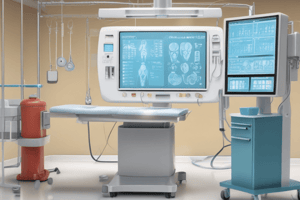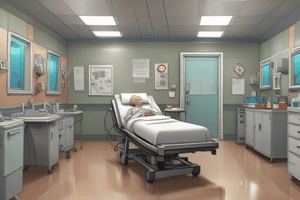Podcast
Questions and Answers
What does cyanosis indicate in a patient?
What does cyanosis indicate in a patient?
- Normal skin color due to healthy perfusion
- Optimal circulation and respiratory function
- Blue or purple discoloration of the skin due to poor oxygenation (correct)
- A sign of warm body temperature
Which of the following respiratory rates is normal for a toddler aged 1 to 2 years?
Which of the following respiratory rates is normal for a toddler aged 1 to 2 years?
- 18 - 25 breaths per minute
- 20 - 28 breaths per minute
- 22 - 37 breaths per minute (correct)
- 30 - 53 breaths per minute
What does the 'GEMS diamond' stand for in geriatric assessments?
What does the 'GEMS diamond' stand for in geriatric assessments?
- General, Environmental, Medical, Safety
- Geriatric, Emotional, Mental, Social
- General, Emotional, Medical, Social
- Geriatric, Environmental, Medical, Social (correct)
Which of the following is NOT a cause of delirium as per the PE triad?
Which of the following is NOT a cause of delirium as per the PE triad?
In infants under 2 months, what is the condition characterized by blue hands or feet known as?
In infants under 2 months, what is the condition characterized by blue hands or feet known as?
What is the GCS score range that indicates mild neurological dysfunction?
What is the GCS score range that indicates mild neurological dysfunction?
Which mechanism is associated with producing abdominal pain related to positive tilt-test results?
Which mechanism is associated with producing abdominal pain related to positive tilt-test results?
How long should the initial assessment take during an assessment process?
How long should the initial assessment take during an assessment process?
What is included in the mental status evaluation method known as COASTMAP?
What is included in the mental status evaluation method known as COASTMAP?
Which of these drugs is classified under Schedule II?
Which of these drugs is classified under Schedule II?
In the pediatric assessment triangle, which of the following corresponds to 'T'?
In the pediatric assessment triangle, which of the following corresponds to 'T'?
What is the average time required to develop, test, and approve a new drug?
What is the average time required to develop, test, and approve a new drug?
What is one of the initial signs of poor circulation, anemia, or hypoxia?
What is one of the initial signs of poor circulation, anemia, or hypoxia?
Flashcards are hidden until you start studying
Study Notes
Narrative Writing Styles
- A way to tell a story using different methods
Scene Assessment
- Scene size-up: Quickly assess the scene for safety hazards
- Mechanism of injury: How the injury occured, helps to determine what injuries are likely
- Number of patients: How many people need treatment
- Resources needed: What equipment and personnel are needed
- Additional help: Are more resources required
- Safety of the scene: This is the primary concern and should be addressed first
Initial Assessment
- This is the most important part of the assessment and should be completed in the first 60-90 seconds
- Determine the patient's level of consciousness and airway
- Identify any life-threatening conditions
- Check for breathing and circulation
- Perform a rapid scan of the patient's body
- Take vital signs
GCS Score Predictions
- 15: No neurological disabilities
- 13-14: Mild dysfunction
- 9-12: Moderate to severe dysfunction
- 3-8: Severe dysfunction
Current Health Status Elements
- Medications
- Allergies
- Past medical history
- Last meal
- Events leading up to the injury
- Pain level
- Mental status
Three (3) Mechanisms that produce ABD pain
- Trauma: Falls, motor vehicle accidents, violence
- Surgical: Complications from surgery such as adhesions or infections
- Medical: Appendicitis, pancreatitis, gastrointestinal bleeding
Tilt-test
- Positive results indicate a decrease in blood pressure and increase in pulse
- The patient may also experience dizziness or lightheadedness
Rapid Trauma Assessment
- This is performed after the initial assessment and before the focused physical examination
- It is a quick assessment of the head, neck, chest, abdomen, pelvis, and extremities
Mental Status Evaluation - COASTMAP
- C: Consciousness - level of alertness
- O: Orientation - awareness of person, place, and time
- A: Activity - level of physical activity
- S: Speech - clarity, fluency, and appropriateness
- T: Thoughts - content and organization
- M: Memory - ability to recall recent and past events
- A: Affect - mood and emotional state
- P: Perception - awareness of surroundings and ability to interpret stimuli
Ongoing Assessment Elements
- Vitals signs: Pulse, respirations, blood pressure
- Level of consciousness
- Pain level
- Appearance
- Skin color and condition
- Pupil size and reactivity
Drug (Definition)
- A substance or mixture of substances manufactured, sold, or represented for use in:
- Diagnosis, treatment, or prevention of disease
- Other than food
- Affecting the structure or function of the body
Health Canada - Approval of Medications
- Health Products and Food Branch (HPFB) is the branch of government that approves medication in Canada.
Medication Names
- Generic name: The chemical name of the drug (Acetaminophen)
- Brand name: The name given to the drug by the manufacturer (Tylenol)
- Trade name: A proprietary name for a drug (Ibuprofen)
Sources of Medicine
- Prescription: Requires a doctor's order
- Over-the-counter: Available without a doctor's order
- Complementary and alternative medicine: Herbal remedies, acupuncture, etc.
- Illicit drugs: Drugs that are illegal to buy, sell, or possess
Scheduled Drugs
- Schedule I: Narcotics such as opium, heroin, morphine, and cocaine
- Schedule II: Cannabis and cannabis resin
- Schedule III: Stimulants such as amphetamines, and hallucinogens such as LSD
- Schedule IV: Anabolic steroids, barbiturates, benzodiazepines
- Schedule V: Repealed
- Schedule VI: Precursors that can be used to create other scheduled drugs
- Schedule VII: Repealed
- Schedule VIII: Repealed
- Schedule IX: Devices that can be used to create tablets or capsules
Drug Development and Approval
- Average time for approval: 9 years
- Testing in animal species: Two species
- Clinical trial phases:
- Phase I: Initial safety and dosage testing in a small group of healthy volunteers
- Phase II: Further safety testing and dosage optimization in a larger group of people with the disease
- Phase III: Large-scale efficacy and safety trials in a diverse patient population
- Phase IV: Long-term surveillance for rare side effects
Pediatric Assessment Triangle
- A quick and easy method for assessing a child's condition
- Appearance: General appearance and demeanor
- Work of breathing: Effort needed to breathe
- Circulation: Skin color, capillary refill, and pulse
Pediatric Appearance Features
- T: Tone - muscle tone
- I: Interactiveness - level of engagement with the environment
- C: Consolability - ability to be comforted
- L: Look or gaze - eye contact and alertness
- S: Speech or cry - quality and strength of cry
Stridor
- Obstruction at the level of the glottis (voice box)
- Causes a high-pitched, whistling sound during breathing
Grunting
- Obstruction in the lower airway
- Used as a form of auto-PEEP (positive end-expiratory pressure) to keep the airways open
Wheezing
- Constricted or blocked small airways
- Causes a whistling or wheezing sound during breathing
Pallor
- Initial sign of poor circulation, anemia, or hypoxia
- Causes a pale skin color
Mottling
- Vasomotor instability in the capillary beds
- Causes a blotchy or mottled skin color
- It can also be a normal response to a cold environment
Cyanosis
- Blue or purple discoloration of the skin and mucous membranes indicating poor perfusion or poor oxygenation
- Caused by low levels of oxygen in the blood
Acrocyanosis
- Blue hands or feet in an infant less than 2 months old
- A normal finding when the infant is cold
How to use a Browlow Tape
- Placement: Place the tape on the child's forehead
- Measurement: Measure the distance between the brow line and the top of the child's head
- Age: Use the tape to determine the child's approximate age
- Medications: Use the tape to estimate the appropriate dosage of medication
Skin CTC
- Color: Skin color
- Temperature: Skin temperature
- Condition: Skin condition. Such as, moist, dry, clammy, or sweaty
Children aged 1 - 10 Minimum BP
- 70 + (age x 2)
Pediatric Respiration Rates
- Age Resp rate HR SBP DBP
Neonate (0 - 1 month) 30 - 60 90 - 160 67 - 84 35 - 53 Infant (1 month - 1 year) 30 - 53 90 - 160 72 - 104 37 - 56 Toddler (1 year - 2 years) 22 - 37 80 - 120 86 - 106 42 - 63 Preschool (3 - 5 years) 20 - 28 65 - 100 89 - 112 46 - 72 School-aged (6 - 12 years) 18 - 25 58 - 90 97 - 120 57 - 80 Adolescent (12 - 15) 12 - 20 50 - 90 110 - 131 64 - 83
Geriatric Assessment Tool - GEMS Diamond
- G: Geriatric patient
- E: Environmental assessment - Living conditions, safety, support systems
- M: Medical assessment - Physical exam, vital signs, medication review
- S: Social assessment - Family and social support, mental status, financial resources
PE Triad
- P: Pain - Assess location, intensity, and quality of pain
- E: Edema - Assess the presence of swelling
- E: Ecchymosis - Assess the presence of bruising
Causes of Delirium
- D: Drugs or toxins
- E: Emotional (depression, anxiety) or electrolytes (sodium, potassium)
- L: Low PaO2 (low oxygen levels)
- I: Infection (pneumonia, urinary tract infection)
- R: Retention of stool or urine
- I: Ictal state (seizures)
- U: Undernutrition or underhydration
- M: Metabolism (thyroid disease, liver failure)
- S: Subdural hematoma (bleeding in the brain)
Types of Elderly Maltreatment
- Physical abuse: Hitting, kicking, slapping, or other physical harm
- Sexual abuse: Any non-consensual sexual contact
- Emotional abuse: Verbal abuse, intimidation, or threats
- Neglect: Failure to provide basic needs such as food, water, shelter, or medical care
- Financial exploitation: Misuse or theft of money or property
Studying That Suits You
Use AI to generate personalized quizzes and flashcards to suit your learning preferences.




